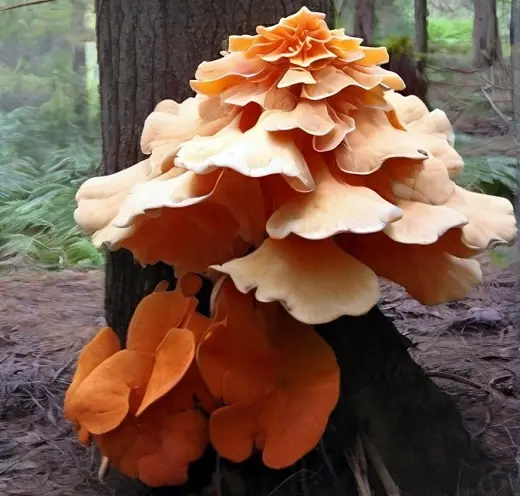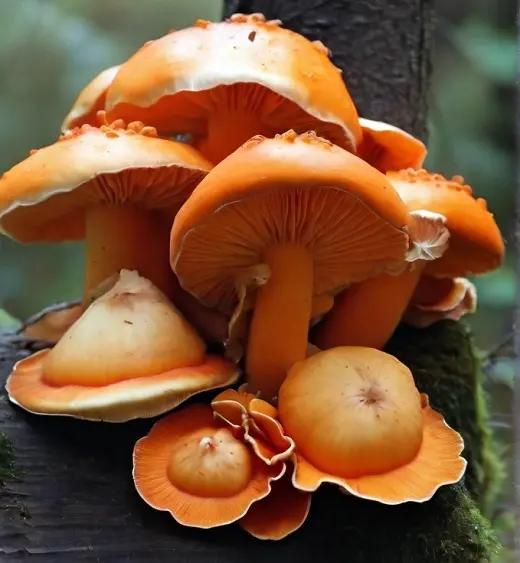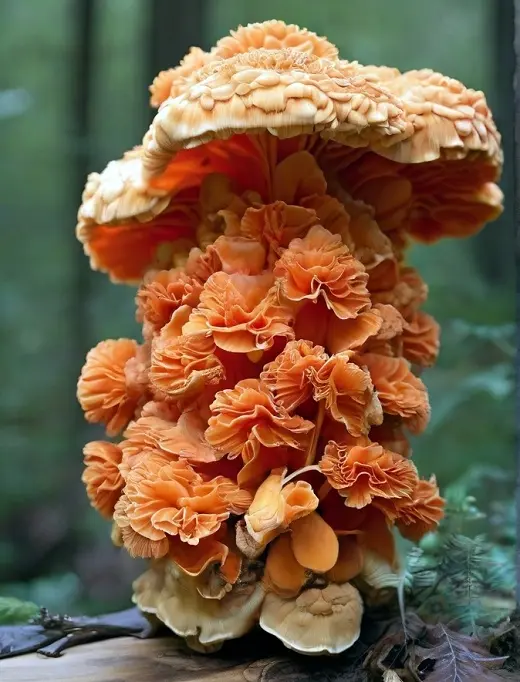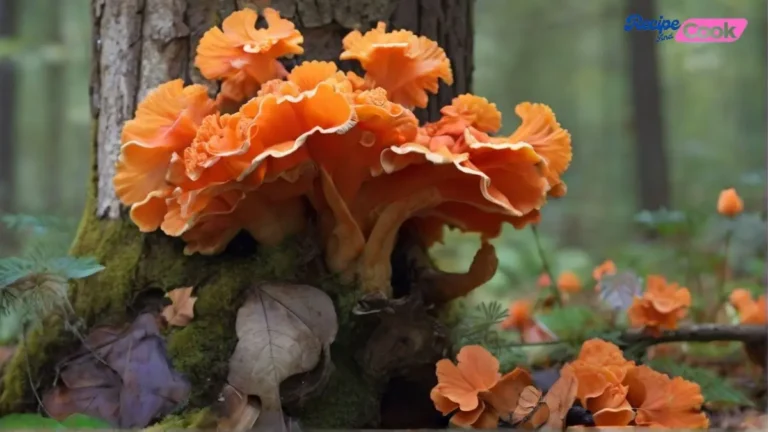Chicken of The Woods, scientifically known as Laetiporus, is a captivating fungus that often baffles and delights foragers and food enthusiasts alike. Its vibrant colors, unique texture, and versatile culinary applications make it a sought-after delicacy in many parts of the world.
In this blog, we’ll embark on a journey to uncover the mysteries and wonders of Chicken of The Woods, exploring its characteristics, culinary uses, health benefits, foraging techniques, cultural significance, and the importance of conservation efforts.
Getting to Know Chicken of The Woods | About Laetiporus
Chicken of The Woods belongs to the genus Laetiporus, which encompasses several species of bracket fungi. These fungi are typically characterized by their large, fan-shaped fruiting bodies that grow in overlapping clusters on trees, logs, or stumps. Depending on the species and maturity.
Chicken of The Woods can display a striking array of colors ranging from bright yellow to orange and even reddish hues.

Found primarily in temperate regions around the world, Chicken of The Woods thrives on dead or decaying wood, particularly hardwoods like oak and chestnut. Its preference for specific tree species, along with its seasonal availability, makes it a prized find for foragers and mushroom hunters.
Culinary Delights: Cooking with Chicken of The Woods
One of the most enticing aspects of Chicken of The Woods is its culinary versatility. With a flavor reminiscent of chicken or seafood, depending on the preparation, this fungus lends itself well to a variety of dishes. From sautéing and grilling to soups, stews, and even vegan “pulled pork” substitutes, the possibilities are endless like garlic jerky.

When harvesting Chicken of The Woods for consumption, it’s essential to gather only young, tender specimens. Older specimens can become tough and less palatable. Proper cleaning and preparation are also crucial to ensure a delicious and safe culinary experience.
Health Benefits and Nutritional Value
Beyond its culinary appeal, Chicken of The Woods offers several potential health benefits. Rich in protein, fiber, vitamins, and minerals, including potassium, selenium, and vitamin C, this fungus can contribute to a well-rounded diet.
Some traditional medicine practices also attribute medicinal properties to Chicken of The Woods, including immune-boosting and anti-inflammatory effects.
However, as with any wild mushroom, caution should be exercised when foraging and consuming Chicken of The Woods. Some individuals may experience adverse reactions, particularly if they have allergies or sensitivities to certain fungi.
It’s always advisable to start with small portions and consult with a healthcare professional if you have any concerns.
Foraging and Identification
Foraging for Chicken of The Woods can be a rewarding experience, but it requires careful attention to detail and knowledge of its distinguishing features. Young specimens typically have a softer texture and vibrant colors, while older specimens may appear tougher and more faded.
It’s essential to avoid misidentifying Chicken of The Woods with potentially toxic look-alike species, such as the sulfur shelf or jack-o’-lantern mushroom.
Before setting out to forage, familiarize yourself with reputable field guides or seek guidance from experienced foragers.
Remember to respect local regulations and obtain permission before harvesting on private property or protected lands. Sustainable foraging practices, such as leaving behind mature specimens to disperse spores and contribute to ecosystem health, are also encouraged.
Cultural Significance and Folklore
Throughout history, Chicken of The Woods has held cultural significance in various societies around the world. In some cultures, it has been revered as a symbol of abundance, fertility, and good fortune. Others have incorporated it into traditional cuisines and folk remedies for ailments ranging from indigestion to wound healing.
In addition to its practical uses, Chicken of The Woods has also inspired myths, legends, and artistic interpretations. Its vibrant colors and whimsical appearance have sparked the imagination of storytellers, artists, and nature enthusiasts alike, adding to its allure and mystique.
Other Similar Mushrooms to Chicken of The Woods Mushroom
While Chicken of The Woods (Laetiporus) stands out for its distinct appearance and culinary appeal, several other mushrooms share similar characteristics and culinary uses. Here are a few noteworthy examples:
1. Sulfur Shelf (Laetiporus sulphureus): Often mistaken for Chicken of The Woods due to its overlapping clusters and vibrant orange-yellow coloration, the sulfur shelf is another edible fungus with a taste reminiscent of chicken when cooked. However, it typically grows on hardwood trees and can sometimes cause gastrointestinal upset if not properly cooked.
2. Hen of The Woods (Grifola frondosa): Also known as maitake, this mushroom grows in large, leafy clusters at the base of trees, particularly oaks. While its texture differs from Chicken of The Woods, it shares a savory flavor profile and is prized for its culinary versatility. Hen of The Woods is often used in soups, stir-fries, and as a meat substitute in vegetarian dishes.

3. Lion’s Mane (Hericium erinaceus): Unlike the bracket fungi of Chicken of The Woods, Lion’s Mane is a toothed fungus with a shaggy, white appearance resembling a lion’s mane. This unique mushroom is prized for its delicate, seafood-like flavor and purported cognitive and nerve-regenerative benefits. It can be enjoyed sautéed, grilled, or incorporated into various dishes.
4. Oyster Mushroom (Pleurotus ostreatus): While not visually similar to Chicken of The Woods, oyster mushrooms share a mild, sweet flavor and a tender, meaty texture when cooked. They grow in overlapping clusters on decaying wood, often resembling oyster shells, hence the name. Oyster mushrooms are versatile in the kitchen and can be used in soups, stir-fries, pasta dishes, and more.
While these mushrooms share some similarities with Chicken of The Woods, each species has its unique characteristics, flavor profiles, and culinary applications. Whether you’re foraging in the wild or exploring gourmet cuisine, discovering and experimenting with different mushroom varieties can add depth and excitement to your culinary adventures.
Just remember to exercise caution and proper identification practices when foraging for wild mushrooms, and always cook them thoroughly before consumption.
In conclusion, Chicken of The Woods is not just a fungus; it’s a window into the fascinating world of mycology and the intricate relationships between fungi, trees, and ecosystems.
Whether you’re a seasoned forager, an aspiring chef, or simply a curious nature enthusiast, exploring the wonders of Chicken of The Woods can lead to a deeper appreciation for the biodiversity and beauty of our natural world.
Followings are some commonly asked questions on this healthy Chicken of the woods mushroom and we have found their answers. Hope this questions and their answers will help you to have a better knowledge on this mushroom.
1. Are chickens of the woods good to eat?
Yes, Chicken of The Woods is considered edible and is prized for its unique flavor and texture. When harvested young and cooked properly, it can resemble the taste and texture of chicken or seafood, depending on the preparation.
2. What’s the best way to eat chicken of the woods?
Chicken of The Woods can be enjoyed in various culinary applications, including sautéing, grilling, frying, roasting, and incorporating into soups, stews, and pasta dishes. The best way to eat it depends on personal preference and the desired flavor and texture.
3. Where does chicken of the woods grow in the US?
Chicken of The Woods can be found throughout the United States, particularly in temperate regions with abundant hardwood forests. It commonly grows on dead or decaying wood, such as oak, chestnut, and beech trees.

4. How rare are chicken of the woods?
Chicken of The Woods is not considered rare in the sense of being endangered or threatened. However, its seasonal availability, specific habitat requirements, and variability in fruiting patterns can make it somewhat unpredictable to find in the wild. It’s essential to forage responsibly and only harvest what you can use to ensure sustainability.
5. Is chicken of the woods safe to eat?
When properly identified and harvested from uncontaminated sources, Chicken of The Woods is generally safe to eat for most people. However, as with any wild mushroom, there is a risk of misidentification or allergic reactions in some individuals. It’s crucial to exercise caution, properly clean and cook the mushroom before consumption, and start with small portions if trying it for the first time.
6. How do I identify chicken of the woods?
Chicken of The Woods is characterized by its large, overlapping clusters of shelf-like fruiting bodies with vibrant yellow, orange, or reddish-orange colors. It typically grows on hardwood trees and has a soft, tender texture when young.
7. Can I cultivate chicken of the woods at home?
While it’s challenging to cultivate Chicken of The Woods indoors due to its specific habitat requirements and complex life cycle, some enthusiasts have successfully grown it on logs or wood chips outdoors. However, it requires careful attention to environmental conditions, substrate preparation, and patience.
8. How long does this mushroom last once harvested?
Chicken of The Woods is best enjoyed fresh but can be stored in the refrigerator for a few days if kept in a paper bag or breathable container to prevent moisture buildup. Alternatively, it can be dried or preserved through freezing for longer-term storage.
9. Are there any poisonous look-alikes to this mushroom?
While Chicken of The Woods is generally easy to identify, there are some poisonous look-alike species, such as the sulfur shelf (Laetiporus sulphureus) and the jack-o’-lantern mushroom (Omphalotus illudens). It’s essential to carefully examine the mushroom’s characteristics and consult reliable field guides or experts when in doubt.
10. Can I eat chicken of the woods raw?
It is not recommended to eat Chicken of The Woods raw due to its tough and indigestible texture in its raw state. Cooking thoroughly before consumption not only enhances its flavor and texture but also eliminates any potential harmful microorganisms or toxins.
So, the next time you encounter this vibrant fungus in the wild or on your plate, take a moment to marvel at its complexity and savor the experience. Happy foraging and bon appétit!


6 comments